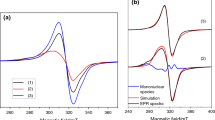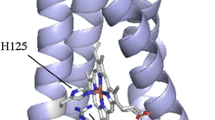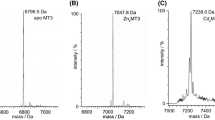Abstract
Owing to the frustrating experience of not being able to obtain crystalline yeast Cu(I)7 -metallothionein, thereby allowing elucidation of the X-ray structure, truncated forms were prepared to facilitate possible crystallization. The mobile remnants at either the N- or C-terminal end of the polypeptide chain were omitted. In parallel with the crystallization efforts, it was of interest to examine the degree to which the shortening of the protein portion might affect the intactness of the Cu(I)7 -thiolate cluster, thereby hampering their use as structural models for the intact protein. 1H two-dimensional NMR spectroscopy at 800 MHz was performed on the intact wild-type yeast Cu7-thionein and on two truncated forms (peptide−1–40 and peptide5–40). The NMR spectral data reveal, regardless of the length of the polypeptide chain, that the spin patterns were fully preserved with all relevant NOEs. The corresponding calculated structures were virtually identical. All other spectrometric properties, including circular dichroism, luminescence and electronic absorption, allowed the same conclusion. Minor differences were observed in the chiroptic and luminescent measurements. Interestingly, however, the resistance towards oxygen was progressively diminished with decreasing length of the polypeptide backbone. The half-life of the luminescence of the wild-type protein was 48 h while the luminescence of the shortest peptide levelled off within 24 h.






Similar content being viewed by others
References
Byrd J, Berger RM, McMillin DR, Wright CF, Hamer D, Winge DR (1988) J Biol Chem 263:6688–6694
Narula SS, Winge DR, Armitage IM (1993) Biochemistry 32:6773–6787
Li YJ, Weser U (1992) Inorg Chem 31:5526–5533
Nielson KB, Winge DR (1984) J Biol Chem 259:4941–4946
Stillman MJ, Law AY, Cai WH, Zelazowski AJ (1987) Experientia Suppl 52:203–211
Romero-Isart N, Vasak M (2002) J Inorg Biochem 88:388–396
Bofill R, Capdevila M, Cols N, Atrian S, Gonzalez-Duarte P (2001) J Biol Inorg Chem 6:405–417
Bertini I, Hartmann HJ, Klein T, Liu G, Luchinat C, Weser U (2000) Eur J Biochem 267:1008–1018
Narula SS, Mehra RK, Winge DR, Armitage IM (1991) J Am Chem Soc 113:9354–9358
Peterson CW, Narula SS, Armitage IM (1996) FEBS Lett 379:85–93
Winge DR, Nielson DB, Gray WR, Hamer DH (1985) J Biol Chem 260:14464–14470
Weser U, Hartmann HJ (1991) Methods Enzymol 205:274–278
Echner H, Voelter W (1988) Liebigs Ann Chem 1095–1097
Macura S, Wüthrich K, Ernst RR (1982) J Magn Reson 47:351–357
Marion D, Wüthrich K (1983) Biochem Biophys Res Commun 113:967–974
Eccles C, Güntert P, Billeter M, Wüthrich K (1991) J Biomol NMR 1:111–130
Assfalg M, Bertini I, Turano P, Bruschi M, Durand MC, Giudici-Orticoni MT, Dolla A (2002) J Biomol NMR 22:107–122
Güntert P, Braun W, Wüthrich K (1991) J Mol Biol 217:517–530
Güntert P, Mumenthaler C, Wüthrich K (1997) J Mol Biol 273:283–298
Koradi R, Billeter M, Wüthrich K (1996) J Mol Graphics 14:51–55
Rupp H, Voelter W, Weser U (1975) Hoppe Seylers Z Physiol Chem 356:755–765
Beltramini M, Lerch K (1983) Biochemistry 22:2043–2048
Roschitzki B, Vasak M (2002) J Biol Inorg Chem 7:611–616
Acknowledgements
The support of the European Community Access to Research Infrastructure action of the Improving Human Potential Programme (LSF user project no. 23) is gratefully acknowledged. Several encouraging and stimulating discussions with Prof. Ivano Bertini are warmly acknowledged.
Author information
Authors and Affiliations
Corresponding author
Additional information
B. Dolderer and C. Del Bianco both contributed substantially and equally to the present study
Rights and permissions
About this article
Cite this article
Luchinat, C., Dolderer, B., Del Bianco, C. et al. The Cu(I)7 cluster in yeast copper thionein survives major shortening of the polypeptide backbone as deduced from electronic absorption, circular dichroism, luminescence and 1H NMR. J Biol Inorg Chem 8, 353–359 (2003). https://doi.org/10.1007/s00775-002-0423-6
Received:
Accepted:
Published:
Issue Date:
DOI: https://doi.org/10.1007/s00775-002-0423-6




